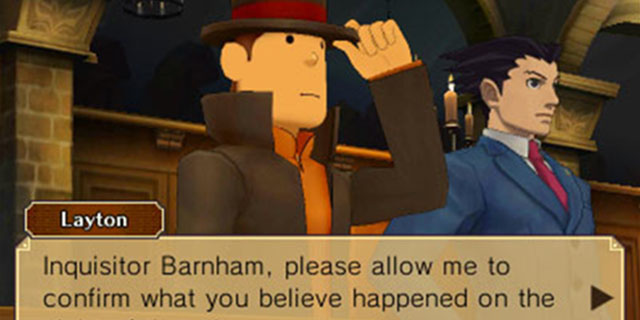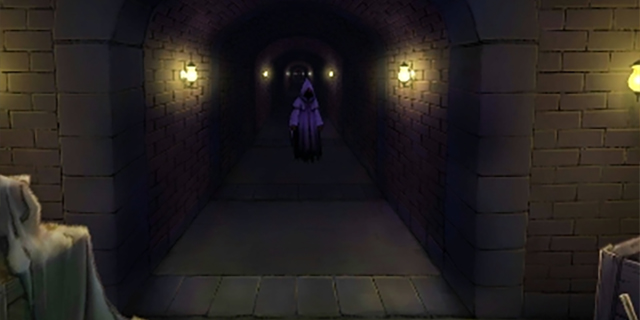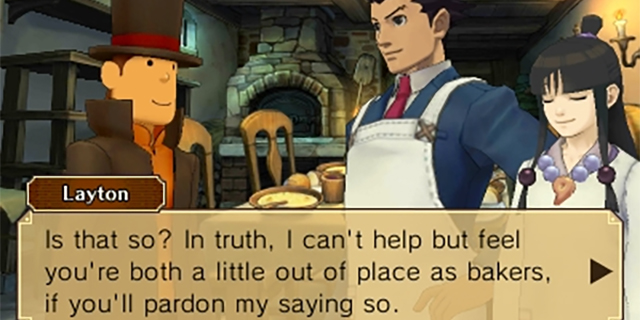
When Professor Layton vs. Phoenix Wright: Ace Attorney was first announced, the respective fan bases of both franchises were sold almost immediately. The two camps have a significant overlap, and those fans had just been exposed to something they knew they wanted very badly yet had never even imagined could be possible. Even fans of only one half of the mix were intrigued by the possibilities of the two worlds colliding.
I am one of those “half” fans. While my love of the good Professor’s adventures is well documented on this site, I have only played one game in the Ace Attorney series (two if you include Harvey Birdman: Attorney at Law). Something about the trial structure and its rigid adherence to doing specific things at very specific times or being penalized never sat right with me. Part of the problem is me guessing where everything is going and jumping the gun for evidence that made sense to me but wasn’t immediately relevant — or relevant to the specific snippet of testimony to which I was objecting, in some cases.
Those problems are still present in PLvPW, but this crossover has one advantage that standard Ace Attorney games do not: hint coins. You still collect a ton of these things over the course of the story like you would in any other Layton title, but never have I enjoyed using them until now. Hint coins remove a lot of the nitpicky guesswork from cross-examinations, and even eliminate several options of evidence before you have to choose the right one.

Fans of Ace Attorney games who might be cool to Layton‘s puzzles are offered less comfort, although as a Layton veteran I did feel that the puzzles were less challenging than usual. There are also fewer of them, with only 70 in the main narrative as opposed to the usual 150-ish. Additional puzzles can be added via free DLC as with the more recent Layton titles, although the distribution appears to be about one a week instead of one per day. Puzzles still award Picarats that are used to gain access to bonus content; Phoenix’s trials also offer Picarats upon their conclusion, with additional bonuses for remaining credibility.
While there isn’t much new to the Layton half of the experience, Phoenix Wright has to deal with several witnesses simultaneously in many of the game’s witch trials. This eventually extends into observing the other witnesses for reactions to the current speaker’s testimony. This is an interesting mechanical twist and a useful tool for the overall narrative, but ultimately doesn’t really add much to the proceedings.
Fortunately, the narrative is interesting enough to make decent use out of both the courtroom antics and the Layton-style exploration which replaces most of the evidence-gathering scenes in an Ace Attorney title. Even the traditional random excuses to present puzzles seem more tied in then usual, although the few hidden puzzles still come out of nowhere for no reason. Each map screen will even tell you whether or not there is a hidden puzzle on it, as well as how many hint coins are secreted therein. This certainly cuts down on the aimless searching, although the magnifying glass cursor (first introduced in Miracle Mask) already did most of that work anyway.

The story itself revolves around the mysterious town of Labyrinthia and its witch problem. Inquisitors capture young women accused of witchcraft, and if they are found guilty they are actually sealed in an iron casket/cage and dropped into a pit of flames! Complicating matters for Phoenix, who is called on to defend a young girl named Espella, is the fact that Labyrinthia is by all appearances a classic medieval village. This means that forensic advancements like fingerprints, voice prints, and even photographs are nowhere to be found. Even worse, magic exists here and that really impacts a lot of otherwise logical arguments. He will have to rely on more traditional methods to protect his charges from a fiery fate.
Fortunately, Professor Layton and Luke have been giving Phoenix and Maya pointers in puzzle-solving. The interactions between these four characters is great, and each chapter of the story manages to mix the “teams” up to keep the conversations fresh. The character models for Phoenix and Maya look odd against the more cartoonish features of the Londoners (especially Layton’s pinprick eyes), but the rest of the cast sort of split the difference and the clash is really only noticeable when it’s just the four of them on-screen.

I believe this is the first time Phoenix and Maya have been voiced outside of their usual courtroom catch phrases. As in the Layton games, this seems to be almost at random outside of the animated cut scenes, but when they do show up, they are not unwelcome. While the Ace Attorney and his assistant also get Layton-style puzzle-answering clips, I was more amused by the court quips given to Layton himself; while the good professor still raises Objections, he’s too much of a gentleman to tell someone to “Take That!”. The scenes where both characters work — and, naturally, point — together are just great.
If there is a glaring flaw to be found in this chocolate-and-peanut butter concoction, it has to be the lengthy exposition sections. Large swaths of the game are nothing but chattering heads, and there is no way to skip past most of them save for mashing on the advance button. This is especially frustrating if you have to replay them, although the only time that happened to me outside of a trial scene was at the very end of the game when I went back to find a puzzle I had missed the first time around. The final trial is especially egregious here, as it spans several chapters in the game (with just the one credibility meter across all of them!) and after a certain point your input is little more than pressing for more information and occasionally presenting an item to further spur memories as you watch the conclusion unfold.

The good news is that by the time you hit that final stretch you’re probably interested in seeing this crazy story make sense. In the finest Layton tradition, even the explanation manages to be logical within the game world but wholly implausible in anything resembling reality. It’s amusing to think that the Ace Attorney universe overlaps with Layton‘s insane one, though.
I don’t think Professor Layton vs. Phoenix Wright will win over any fans of only one of the series, as the respective shortcomings of each ingredient are still on display here, if ameliorated somewhat. Even if this game isn’t as solid as a “pure” entry in either franchise, however, it’s still better than never getting the game at all. Kudos to Level-5, Capcom and Nintendo for taking this chance.
Pros: Mixing of characters and gameplay works well
Cons: Too much exposition, each series’s respective flaws still apparent



















